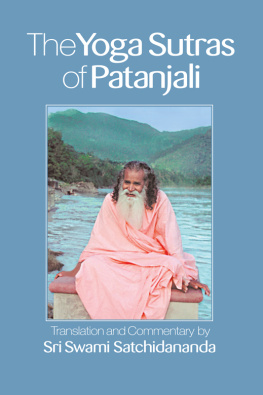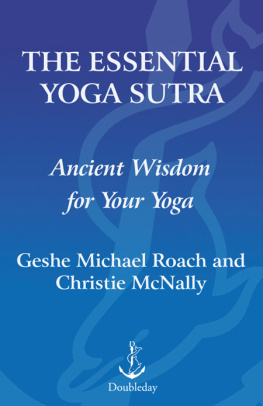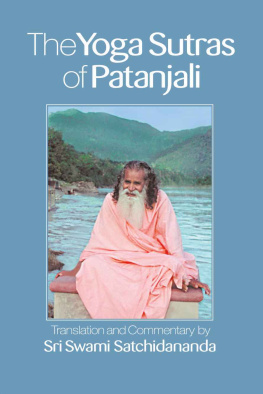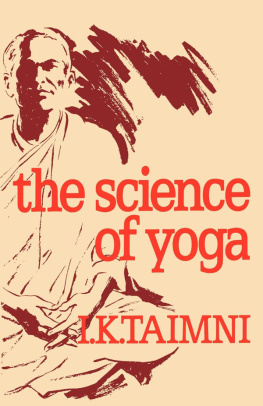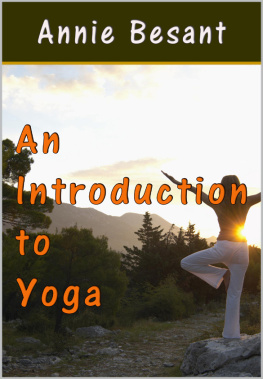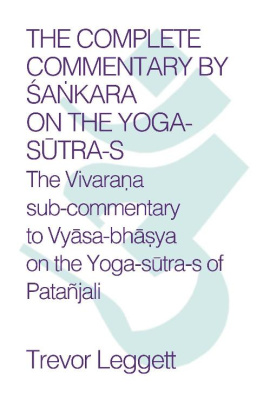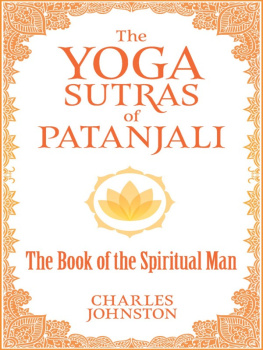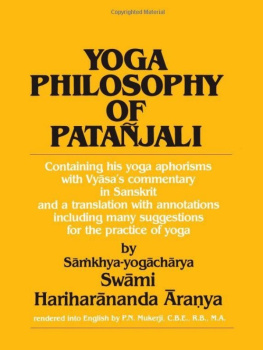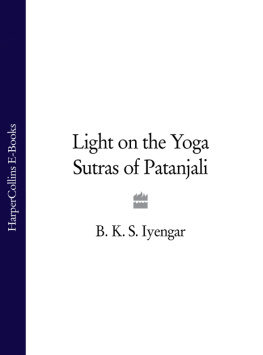The Yoga Sutras
of Patanjali
Translation and Commentary by
Sri Swami Satchidananda
Pocket Edition
Integral Yoga Publications
Buckingham, Virginia
Library of Congress Cataloging in Publication Data:
Satchidananda, Swami
Integral Yoga
Bibliography: P.
I. Yoga. I. Patanjali. Yoga Sutras. 1985
II. Title.
B132.Y6S374 1985 181.452 85-125
Pocket Edition ISBN 978-0-932040-28-2
1st Printing 1985
2nd Printing 1998
3rd Printing 2002
4th Printing 2014
Copyright 1985; cover design 2014 by Satchidananda AshramYogaville, Inc.
All Rights Reserved. Except as permitted under the U.S. Copyright Act of 1976, no part of this publication may be reproduced, distributed, or transmitted in any form or by any means, or stored in a database or retrieval system, without the prior written permission of the publisher or the copyright holder.
Integral Yoga Publications
Satchidananda AshramYogaville
Buckingham, Virginia 23921 USA

The publication of this work is
humbly offered to my beloved and
revered Yoga Master,
Sri Gurudev,
Swami Sivanandaji Maharaj,
and
to all who seek understanding and
mastery over their minds through
the glorious science of Yoga.
Note: Also available from Integral Yoga Publications are three other formats of The Yoga Sutras of Patanjali by Sri Swami Satchidananda: the original paperback edition (including Sanskrit Devanagari script, English transliteration, word-by-word translation, full commentary by Swami Satchidananda, full glossary, pronunciation guide, and index; an eBook edition of the original paperback edition; and an audiobook (available on CD or via digital download) with all the sutras chanted in Sanskrit by Dr. M. A. Jayashree, followed by the English translation, and commentary by Sri Swami Satchidananda (read by Rev. Sam Rudra Swartz). The audiobook includes a bonus portion: sutra-by-sutra chanting in Sanskrit with English translation.
Additionally available is the book, Inside the Yoga Sutras: A Comprehensive Sourcebook for the Study & Practice of Patanjalis Yoga Sutras by Rev. Jaganath Carrera (senior disciple of Sri Swami Satchidananda and Integral Yoga master teacher).
Contents
Book 1: SAMADHI PADA
Portion on Contemplation
Book 2: SADHANA PADA
Portion on Practice
Book 3: VIBHUTI PADA
Portion on Accomplishments
Book 4: KAIVALYA PADA
Portion on Absoluteness
For a long time students have been requesting a pocket edition of The Yoga Sutras of Patanjali to use as an easy study guide and companion on their yogic path. I am happy to see that the present day Yoga students find the Yoga Sutras as useful today as they have been to me and to a long succession of spiritual aspirants for the past several thousand years.
I recommend that this book be studied slowly and carefully. Meditate on each sutra. If you memorize them they will come into your mind just when you need them most. Remember that practice is the most important part of all. Find those sutras that are particularly meaningful to you and practice them to the best of your ability. You will have success and peace.
Let us know that all these ideas and practices are there to help us to forget our personal selfishness and broaden our minds more and more. Every day let us check our progress and see that we grow a little better. Every day should elevate us a little, broaden our attitudes, reduce our selfishness, and make us better masters over our own body, senses, and mind. This is the kind of Yoga that will really help us.
Let that highest goal toward which Patanjalis Yoga Sutras point be our goal: that one day we should all attain the highest samadhi, the totally liberated state. This liberation is not for the remote future, or for when we die; it is to be lived in the very midst of the world. OM Shanti.
May each one of you be blessed with peace and joy, love, and light.
Ever yours in Yoga,
Swami Satchidananda
Satchidananda Ashram-Yogaville, Virginia
June, 1985
I gratefully acknowledge the generous assistance of the late T. M. P. Mahadevan, Ph.D., Professor of Philosophy, University of Madras, for his scholarly assistance in checking over the translations from Sanskrit to English.
I would especially like to thank Vidya Vonne for editing this book from the original edition of The Yoga Sutras of Patanjali.
To them, and to all others who directly or indirectly aided in this work, I offer my sincere thanks. May they all enjoy the peace and joy of Yoga.
When the word Yoga is mentioned, most people immediately think of some physical postures for stretching and stress reduction. This is one aspect of the yogic science, but actually only a small part and relatively recent in development. The physical Yoga, or Hatha Yoga, was primarily designed to facilitate the real practice of Yoganamely, the understanding and complete mastery over the mind. So the actual meaning of Yoga is the science of the mind.
Traditionally the word Yoga by itself refers to Raja Yoga, the mental science. With the current burgeoning of interest in expanding consciousness and in mental science in general, it is natural that we turn to Raja Yoga. The primary text of Raja Yoga is called The Yoga Sutras of Patanjali.
There are, of course, many Western approaches to the study and control of mind, each advancing various different concepts and techniques. Compared to these, however, the ancient yogic science is a great grandsire. For thousands of years the yogis have probed the mysteries of the mind and consciousness.
Sutra literally means thread, each sutra being the barest thread of meaning upon which a teacher might expand by adding his or her own beads of experience for the sake of the students. There are almost 200 sutras, traditionally divided into four sections.
The first is the Portion on Contemplation (Samadhi Pada) that gives the theory of Yoga and a description of the most advanced stages of the practice of samadhi, or contemplation. This probably was given first as an inspiration to the student to begin the practices.

